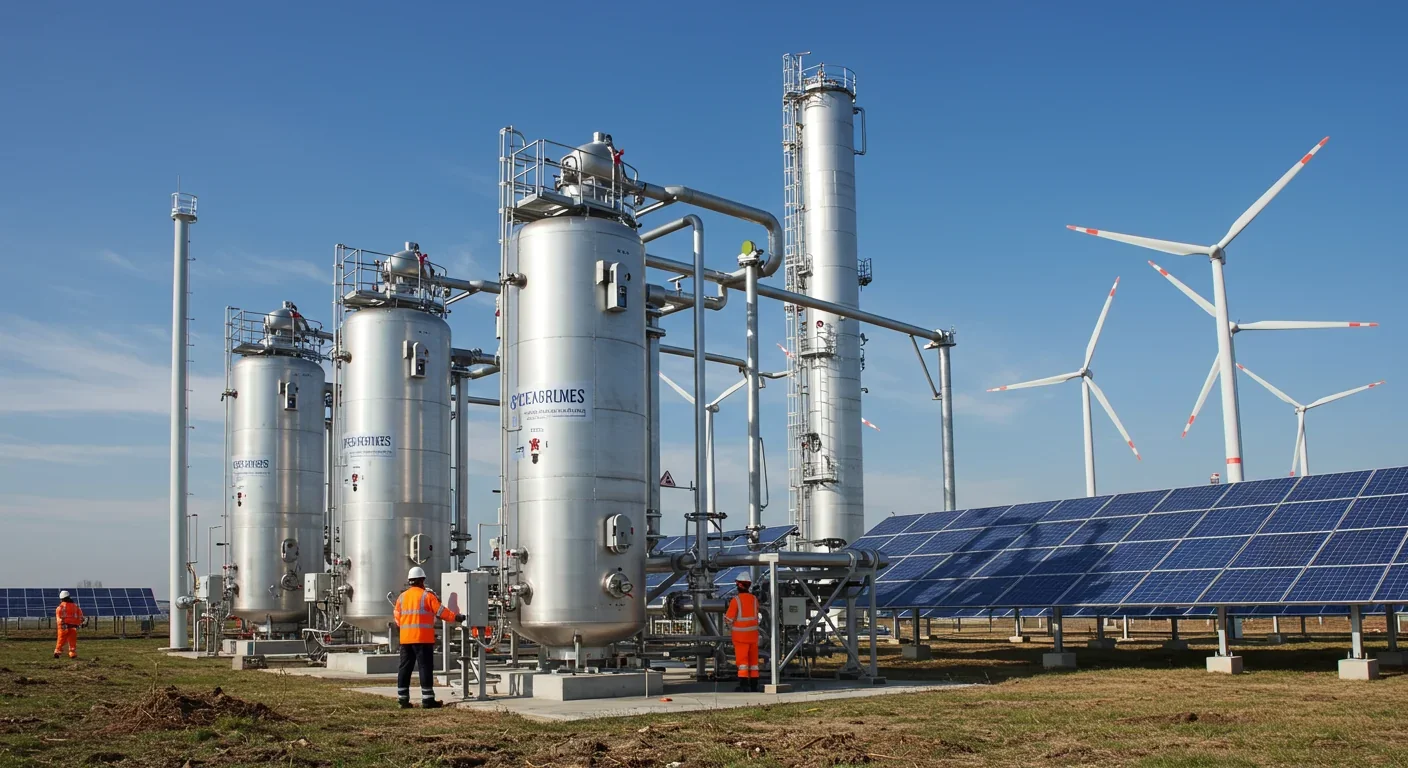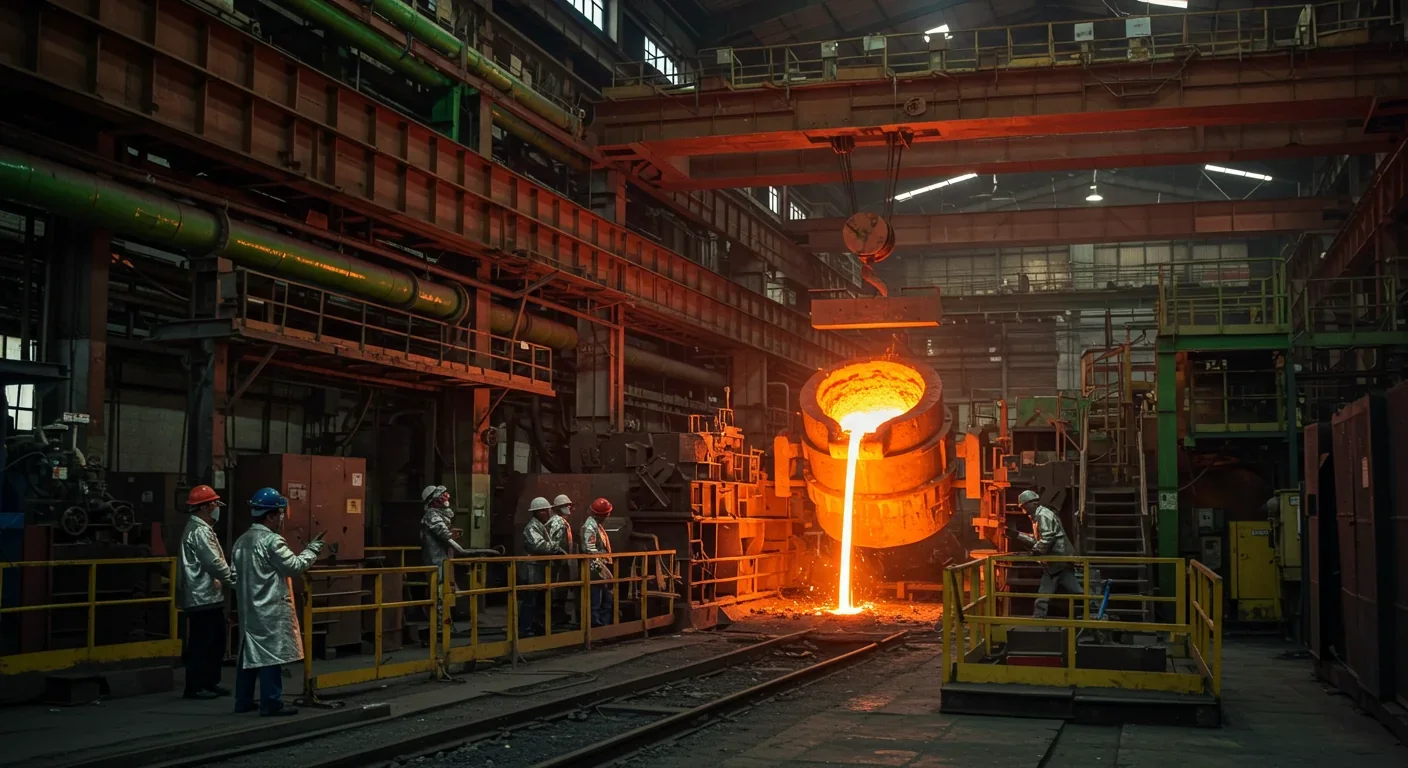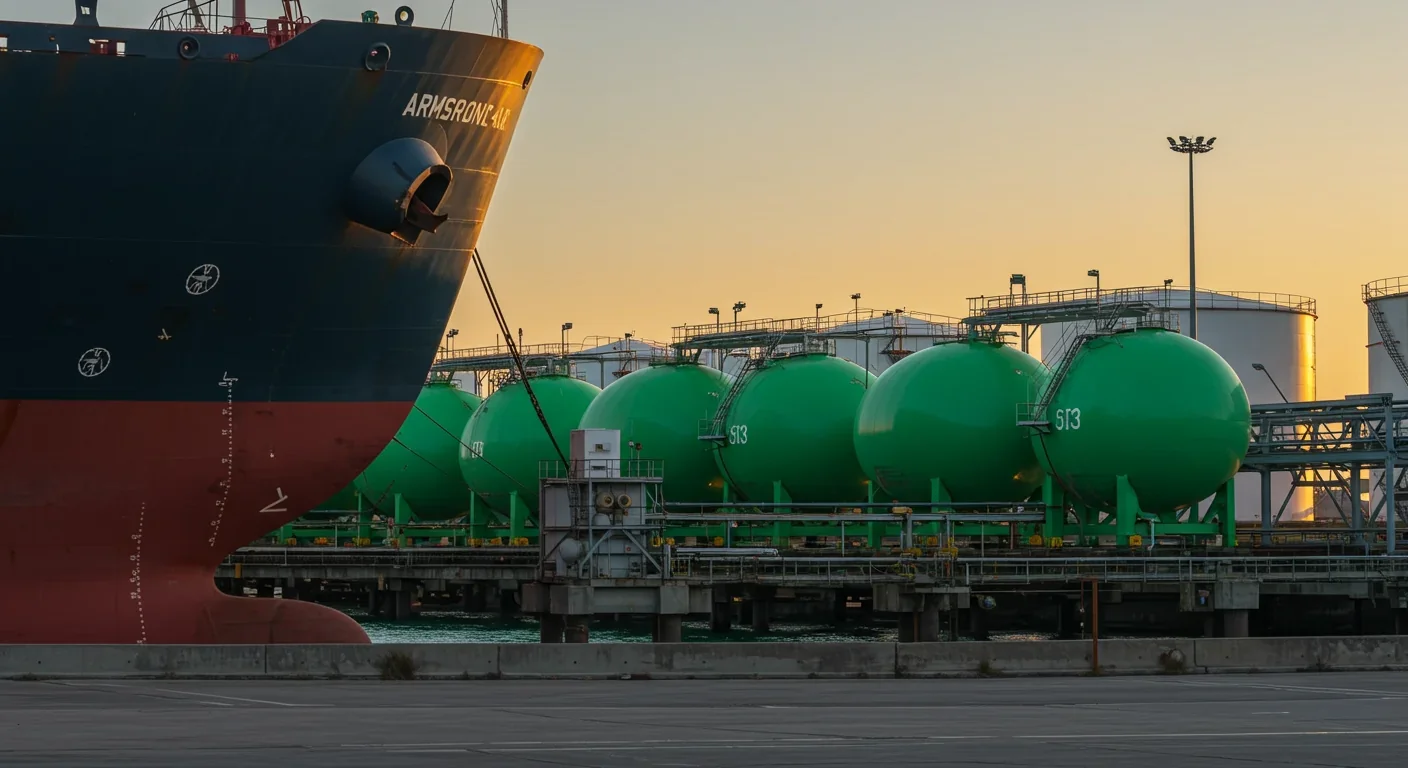Digital Pollution Tax: Can It Save Data Centers?

TL;DR: Green hydrogen is transforming heavy industry through electrolysis technology that uses renewable electricity to produce zero-carbon fuel. Despite cost challenges and project delays, $110 billion in committed investments and operational facilities in Sweden and South Africa prove the technology works at scale, positioning hydrogen to supply 15-25% of industrial energy by 2035.

By 2035, experts predict green hydrogen could supply up to 24% of the world's industrial energy needs, fundamentally reshaping how we make steel, cement, and chemicals. Right now, in northern Sweden, a sprawling facility is already turning this prediction into reality. Stegra's revolutionary plant has installed 740 megawatts of electrolyzers that split water into hydrogen using nothing but renewable electricity. This single project will cut steel production emissions by 95% compared to traditional methods. The age of fossil-fueled heavy industry is ending, and hydrogen is writing the next chapter.
Green hydrogen production starts with electrolysis, a deceptively simple process where electricity splits water molecules into hydrogen and oxygen. Unlike grey hydrogen, which comes from natural gas and releases carbon dioxide, or blue hydrogen, which captures those emissions, green hydrogen produces zero carbon at the source. The International Energy Agency reports that global hydrogen demand reached nearly 100 million tonnes in 2024, growing 2% year-over-year.
The real breakthrough isn't just making hydrogen cleanly. It's integrating it into industrial processes that have relied on coal and natural gas for over a century. In steelmaking, hydrogen-based direct reduction replaces coke-fired blast furnaces with shaft furnaces that use hydrogen to strip oxygen from iron ore. South Korea's Posco is pioneering HyREX technology, which allows direct-reduced iron produced with hydrogen to feed directly into electric arc furnaces, eliminating multiple energy-intensive steps.
China currently dominates electrolyzer manufacturing, accounting for 65% of global installed capacity and nearly 60% of production capability. This concentration has driven costs down through scale, though it also raises questions about supply chain resilience. Electrolyzer prices have actually increased recently due to supply constraints, widening the cost gap between green and grey hydrogen as natural gas prices fell.
Steel has an emissions problem. The industry produces roughly 7% of global CO2 emissions, and most of that comes from blast furnaces burning coal to reach the 1,500°C temperatures needed to smelt iron ore. Hydrogen offers an elegant solution because the chemical reaction produces only water vapor as a byproduct.
Sweden's SSAB operates the world's first meaningful-scale hydrogen steelmaking facility through its Hybrit pilot plant in Luleå. The plant demonstrates that hydrogen can work in real production environments, not just laboratories. Meanwhile, Stegra's full-scale facility in Boden will produce 2.5 million metric tons of green steel by 2028, scaling to 5 million tons by 2030.
South Korea's steel giants are taking a phased approach. Hyundai Steel developed its Hy-Cube concept, which tests blending electric steel from arc furnaces with traditional blast furnace output. The company aims to reduce emissions to 1.8 tonnes of CO2 per tonne of steel through this hybrid method, then push toward 0.2 tonnes using hydrogen direct reduction with carbon capture. Posco's Gwangyang mill ranked number one globally for CO2 emissions in 2022, making its transformation all the more significant.
Cement production faces different challenges. The chemical process of converting limestone to clinker inherently releases CO2, so hydrogen can only address the emissions from heating, not the process emissions. Still, that represents roughly 40% of cement's carbon footprint. Research into hydrogen-powered kilns is advancing, though the high temperatures required make this technically demanding.
The chemicals sector, particularly ammonia production, presents hydrogen's most straightforward industrial application. Ammonia is already made from hydrogen and nitrogen, so switching to green hydrogen simply means changing the hydrogen source. South Africa's R105 billion Coega project will produce one million tonnes of green ammonia annually using wind-powered electrolysis, with construction potentially starting in 2027.

Cost remains hydrogen's biggest obstacle. Green hydrogen currently costs two to three times more than grey hydrogen from natural gas. The gap has widened recently because natural gas prices dropped while electrolyzer costs increased. This price dynamic creates a challenging investment environment where companies must bet on future cost reductions.
Yet some projects are proceeding anyway. Stegra secured €6.5 billion from private investors even after Sweden's Environmental Agency denied a €165 million grant. Microsoft invested through its $1 billion Climate Innovation Fund and will purchase environmental attribute certificates to help cover the premium for green steel. This model of corporate offtake agreements signals a demand that extends beyond traditional steel buyers.
The capital expenditure for hydrogen infrastructure is substantial. A complete green steel facility requires not just electrolyzers but also renewable energy generation, hydrogen storage, modified furnaces, and new safety systems. South Korea's hydrogen roadmap projects domestic production of 250,000 tonnes of green hydrogen by 2030, plus imports of 1.96 million tonnes to meet industrial demand. The country's steel companies are investing $140 million just in scrap collection centers to prepare for the transition.
Operating costs tell a more optimistic story. Once built, green hydrogen facilities powered by renewable electricity have lower fuel costs than fossil alternatives, especially as carbon pricing increases. The European Union's carbon border adjustment mechanism will tax high-carbon imports starting in 2026, creating a competitive advantage for low-emission producers. Industries that don't transition face both regulatory penalties and market exclusion.
Government support has been inconsistent, and that uncertainty shows in project pipelines. The IEA's latest review found that potential low-emissions hydrogen production capacity dropped from 49 million tonnes per year to 37 million tonnes per year between 2024 and 2025. Electrolysis projects accounted for over 80% of the decline. Delays and cancellations hit projects across Africa, the Americas, Europe, and Australia.
Despite this pipeline shrinkage, committed projects that have reached final investment decisions will still increase production fivefold by 2030, to 4.2 million tonnes per year. The Hydrogen Council reports $110 billion in committed investments across 500-plus projects that are past financial close, under construction, or already operational.
Policy frameworks vary dramatically by region. South Korea's K-ETS emissions trading system covers 79% of national greenhouse gas emissions but still provides free quotas to steel producers, limiting immediate economic pressure to decarbonize. The country introduced K-Taxonomy standards to encourage green bonds, creating a mixed environment where subsidies coexist with emissions exemptions.
The United States passed the Inflation Reduction Act with tax credits of up to $3 per kilogram for clean hydrogen production, potentially closing much of the cost gap with fossil fuels. The European Union launched its Important Projects of Common European Interest program to fund cross-border hydrogen infrastructure. China, meanwhile, has taken a more direct approach through state-led industrial policy and massive domestic electrolyzer deployment.
Beyond announcements and roadmaps, hydrogen is already flowing through industrial facilities. The Coega Green Ammonia project in South Africa's Nelson Mandela Bay advanced to front-end engineering design stage in 2025. The project will install 3,300 megawatts of renewable energy capacity, including 1,000 megawatts from the Carissa wind facility's 154 turbines. Construction could begin in early 2027, with commissioning by December 2029.
BASF, the German chemicals giant, is testing hydrogen integration at multiple facilities. The company aims to replace natural gas with hydrogen in ammonia synthesis and methanol production. Early results show the technology works, but scaling requires massive renewable energy capacity that doesn't yet exist in many regions.
Shipping faces unique challenges because vessels need energy-dense fuels for long voyages. Hydrogen's low density means ships must carry either compressed gas in heavy pressure vessels or liquid hydrogen in cryogenic tanks. Ammonia emerges as a more practical hydrogen carrier for maritime transport, though it brings its own handling and safety requirements. The IEA identifies nearly 80 ports worldwide that already handle chemical products and could become early adopters of hydrogen-based fuels.
Posco's 300,000-tonne-per-year HyREX pilot project at its Pohang plant represents the first commercial-scale test of hydrogen-based direct reduction integrated with electric arc furnace steelmaking. Construction is slated to begin after 2030, with operations demonstrating whether the technology can achieve the cost and quality targets needed for industry-wide adoption.

Storage and transport remain major technical hurdles. Hydrogen molecules are tiny and leak through many materials. The gas is also explosive across a wide range of concentrations in air. Industrial facilities need extensive safety systems, from leak detectors to ventilation to training protocols for workers handling a fuel that burns with an invisible flame.
Infrastructure presents a chicken-and-egg problem. Heavy industries won't commit to hydrogen until reliable supply exists, but energy companies won't build hydrogen production capacity without guaranteed customers. South Korea plans to import 22.9 million tonnes of green hydrogen by 2050, requiring ships, ports, and pipeline networks that don't yet exist at scale.
The workforce transition affects millions of people employed in fossil fuel industries. Coal mining regions face economic disruption as steel mills switch to hydrogen. Some skills transfer directly—metallurgists still need metallurgy knowledge—but others require retraining. Electricians must learn about high-voltage DC systems for electrolyzers. Safety officers need new protocols for hydrogen handling.
Water availability is often overlooked. Producing one kilogram of green hydrogen through electrolysis requires roughly nine kilograms of purified water. The Coega project's seawater abstraction, desalination, and demineralization systems represent a significant portion of project complexity and cost. In water-stressed regions, competition between hydrogen production and other uses could create social tensions.
Technical standards remain fragmented. Different countries define "green" hydrogen differently, with varying thresholds for renewable electricity and emissions. This inconsistency complicates international trade and investment. The IEA notes that policy uncertainty contributed significantly to recent project delays and cancellations.
Project pipelines may be shrinking, but the fundamental trajectory points toward growth. Global hydrogen demand continues rising 2% annually, and heavy industries have no other path to deep decarbonization. Airlines might use sustainable aviation fuel from biomass, but there's no biomass solution for making steel or cement at scale.
Technology improvements are accelerating. Electrolyzer efficiency keeps climbing, while costs should decrease as manufacturing scales up beyond China's current dominance. Solid oxide electrolyzers, which operate at high temperatures and can integrate with industrial waste heat, could dramatically improve system efficiency. Research into new catalyst materials aims to reduce the platinum and iridium needed in current designs.
Market share projections vary, but most analyses suggest green hydrogen could supply 15-25% of industrial energy by 2035. Steel leads the transition because the chemistry is straightforward and the carbon price premium creates clear economic incentives. Cement follows a decade behind due to technical complexity. Shipping might move faster if maritime carbon regulations tighten.
The geopolitical landscape is shifting. Countries with abundant renewable resources—Australia, Chile, parts of Africa—position themselves as future hydrogen exporters. Microsoft's agreement to purchase green steel attribute certificates from Stegra demonstrates how demand can come from unexpected sectors. Tech companies building data centers become steel buyers not because they need construction materials, but because they need carbon offsets.
China's electrolyzer dominance mirrors its earlier control of solar panel manufacturing. The pattern suggests Western countries will likely import much of the equipment even if they produce hydrogen domestically. This dependency raises strategic questions about supply chain security in the energy transition.
Industrial engineers must now think in systems. Designing a green steel plant means understanding not just metallurgy but also renewable energy generation, grid integration, hydrogen storage, and carbon accounting. Hyundai Steel's partnership with Primetals Technologies to research hydrogen use in blast furnaces exemplifies how technology development increasingly requires collaboration between traditional industrial firms and energy system specialists.
Policymakers need to move beyond pilot project grants toward comprehensive frameworks that provide long-term certainty. The Swedish Environmental Agency's denial of Stegra's grant didn't stop the project, but it likely delayed it. Worse, it signaled unreliability that affects investor confidence across the sector.
Investors must develop expertise in evaluating technology readiness, understanding that green hydrogen sits in an awkward valley between proven technology and commercial viability. The chemistry works, the engineering is sound, but the economics depend on factors like future carbon prices and competing energy costs that remain uncertain.
Workers in heavy industry should view this transition not as a threat but as a generational upgrade of their sector. Steel employment won't disappear; it will change. The same applies to cement and chemicals. Early adopters who gain hydrogen expertise position themselves advantageously.
The transformation won't happen overnight. Blast furnaces have 40-year lifespans, and nobody demolishes working industrial facilities. The transition will be phased, with new capacity built green while old assets depreciate naturally. Some existing facilities will retrofit hydrogen capabilities, as Posco and Hyundai are attempting, while others will simply age out.
Regional differences will be dramatic. Areas with cheap renewable electricity—Iceland, Norway, Chile, parts of Australia—might see rapid hydrogen industry development. Regions dependent on fossil fuel exports face harder choices. The Middle East's oil-producing nations are already investing in hydrogen to maintain energy export markets beyond the oil era.
The IEA's Executive Director Fatih Birol captured the current moment well: "The latest data indicates that the growth of new hydrogen technologies is under pressure due to economic headwinds and policy uncertainty, but we still see strong signs that their development is moving ahead globally."
That assessment is accurate. Yes, projects are being delayed. Yes, costs remain higher than hoped. But the direction is set. Heavy industry will run on hydrogen because there's no alternative that achieves similar emission reductions. The only question is timing, and timing matters enormously for which countries, companies, and workers benefit from the transition versus those who scramble to catch up after the winners have already moved.
Microsoft's investment in Stegra shows the future market structure. Green industrial products will command premium prices justified by carbon accounting and corporate sustainability commitments. That premium gradually narrows as carbon prices rise and green technology scales. Eventually the premium disappears entirely, and fossil-based production becomes the expensive option.
We're living through that transition now. The 740 megawatts of electrolyzers being installed in Sweden represent more than a single facility. They're proof that green hydrogen works at industrial scale. The one million tonnes of green ammonia planned for South Africa demonstrate developing economies can participate. The $110 billion already committed to hydrogen projects globally shows capital is flowing despite uncertainties.
Heavy industry built the modern world through fire—burning coal, oil, and gas to forge steel, bake cement, and synthesize chemicals. The next industrial age will be built through water and electricity, splitting molecules and recombining them without combustion. Hydrogen is how we maintain industrial civilization while eliminating its carbon footprint. The transformation has begun.

Recent breakthroughs in fusion technology—including 351,000-gauss magnetic fields, AI-driven plasma diagnostics, and net energy gain at the National Ignition Facility—are transforming fusion propulsion from science fiction to engineering frontier. Scientists now have a realistic pathway to accelerate spacecraft to 10% of light speed, enabling a 43-year journey to Alpha Centauri. While challenges remain in miniaturization, neutron management, and sustained operation, the physics barriers have ...

Epigenetic clocks measure DNA methylation patterns to calculate biological age, which predicts disease risk up to 30 years before symptoms appear. Landmark studies show that accelerated epigenetic aging forecasts cardiovascular disease, diabetes, and neurodegeneration with remarkable accuracy. Lifestyle interventions—Mediterranean diet, structured exercise, quality sleep, stress management—can measurably reverse biological aging, reducing epigenetic age by 1-2 years within months. Commercial ...

Data centers consumed 415 terawatt-hours of electricity in 2024 and will nearly double that by 2030, driven by AI's insatiable energy appetite. Despite tech giants' renewable pledges, actual emissions are up to 662% higher than reported due to accounting loopholes. A digital pollution tax—similar to Europe's carbon border tariff—could finally force the industry to invest in efficiency technologies like liquid cooling, waste heat recovery, and time-matched renewable power, transforming volunta...

Humans are hardwired to see invisible agents—gods, ghosts, conspiracies—thanks to the Hyperactive Agency Detection Device (HADD), an evolutionary survival mechanism that favored false alarms over fatal misses. This cognitive bias, rooted in brain regions like the temporoparietal junction and medial prefrontal cortex, generates religious beliefs, animistic worldviews, and conspiracy theories across all cultures. Understanding HADD doesn't eliminate belief, but it helps us recognize when our pa...

The bombardier beetle has perfected a chemical defense system that human engineers are still trying to replicate: a two-chamber micro-combustion engine that mixes hydroquinone and hydrogen peroxide to create explosive 100°C sprays at up to 500 pulses per second, aimed with 270-degree precision. This tiny insect's biochemical marvel is inspiring revolutionary technologies in aerospace propulsion, pharmaceutical delivery, and fire suppression. By 2030, beetle-inspired systems could position sat...

The U.S. faces a catastrophic care worker shortage driven by poverty-level wages, overwhelming burnout, and systemic undervaluation. With 99% of nursing homes hiring and 9.7 million openings projected by 2034, the crisis threatens patient safety, family stability, and economic productivity. Evidence-based solutions—wage reforms, streamlined training, technology integration, and policy enforcement—exist and work, but require sustained political will and cultural recognition that caregiving is ...

Every major AI model was trained on copyrighted text scraped without permission, triggering billion-dollar lawsuits and forcing a reckoning between innovation and creator rights. The future depends on finding balance between transformative AI development and fair compensation for the people whose work fuels it.